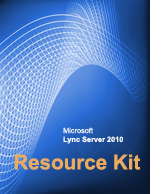Microsoft Lync Server 2010 Resource Kit: Direct SIP
 When Microsoft Lync Server 2010 communications software is deployed in an enterprise environment that already has telephony infrastructure, some level of interoperability is required. This allows users and devices on the existing infrastructure to communicate with Lync Server 2010 users and devices. Direct Session Initiation Protocol (SIP) is referred to as a SIP trunk between an IP-PBX and Lync Server. Because SIP is a standards-based protocol, communications between endpoints on either the IP-PBX or the Lync Server call control plane can be provided by using direct SIP. Download this and other Microsoft Lync Server 2010 Resource Kit chapters from the Download Center.
When Microsoft Lync Server 2010 communications software is deployed in an enterprise environment that already has telephony infrastructure, some level of interoperability is required. This allows users and devices on the existing infrastructure to communicate with Lync Server 2010 users and devices. Direct Session Initiation Protocol (SIP) is referred to as a SIP trunk between an IP-PBX and Lync Server. Because SIP is a standards-based protocol, communications between endpoints on either the IP-PBX or the Lync Server call control plane can be provided by using direct SIP. Download this and other Microsoft Lync Server 2010 Resource Kit chapters from the Download Center.
Author: Taimoor Husain
Publication date: June 2011
Product version: Microsoft Lync Server 2010
The upcoming Microsoft Lync Server 2010 Resource Kit book will provide in-depth technical content about Lync Server 2010. The book will focus on professionals who want to understand more about how the product works internally. You can download this and other Microsoft Lync Server 2010 Resource Kit chapters from the Download Center.
When Microsoft Lync Server 2010 communications software is deployed in an enterprise environment that already has telephony infrastructure, some level of interoperability is required. This allows users and devices on the existing infrastructure to communicate with Lync Server 2010 users and devices.
Direct SIP is referred to as a SIP trunk between an IP-PBX and Lync Server. Because SIP is a standards-based protocol, communications between endpoints on either the IP-PBX or the Lync Server call control plane can be provided by using direct SIP. It can also be used to enhance the existing telephony infrastructure by extending Microsoft Lync 2010 features such as dial-in audio conferencing and Response Groups to the IP-PBX.
Summary
Direct SIP is the most straightforward way to achieve interoperability between an IP-PBX and Lync Server. Direct SIP provides a standards-based interface for signaling and media for audio communications. Direct SIP supports the following use cases:
- Use Simultaneous Ring feature on IP-PBX or Lync Server to ring both IP-PBX handset and Lync 2010
- Call from IP-PBX handset to Lync 2010
- Call from Lync 2010 to IP-PBX handset
- Call from IP-PBX handset to dial-in conferencing on Lync Server
- Call from IP-PBX handset to Lync Server Response Group
- PSTN access for Lync Server through IP-PBX
Lync Server Resources
- Lync Server 2010 documentation in the TechNet Library
- NextHop blog
- Lync Server and Communications Server resources